Polish poster art in post-war Germany
Mediathek Sorted





















![ill. 22: Tomasz Sarnecki, Solidarność ill. 22: Tomasz Sarnecki, Solidarność - W samo poludnie [High noon], 4 June 1989](/sites/default/files/styles/width_100_tiles/public/assets/images/abb22.jpg?itok=ASCM67H8)
![ill. 23: Magazine ‘Jenseits der Oder’ [Beyond the Oder], Issue 6 ill. 23: Magazine ‘Jenseits der Oder’ [Beyond the Oder], Issue 6 - Published by the German Society for Cultural and Economic Exchange with Poland. Due to the unresolved border status from the perspective of the FRG, the title of the magazine was a provocation.](/sites/default/files/styles/width_100_tiles/public/assets/images/abb23.jpg?itok=xaW1FoEX)
![ill. 24: Jan Lenica, Wizyta starszej pani [A visit from an elderly lady] ill. 24: Jan Lenica, Wizyta starszej pani [A visit from an elderly lady] - Announcement of a theatre performance](/sites/default/files/styles/width_100_tiles/public/assets/images/abb24.jpg?itok=a4ssK6p6)




5. "Polish Poster Schools"?
This success was reflected not least in the fact that in the Federal Republic of Germany too, people soon only spoke of the "Polish poster school", a name which is still used today. When, how and through whom the term came into circulation is as controversial as the question of what the Polish poster school as such is supposed to mean. And there are already various suggestions regarding the time frame. The term is also problematic or at least misleading insofar as it suggests a consistency and coherence that scarcely existed. Not only do worlds seem to lie between the folkloric-humoristic operetta posters of someone like Józef Mroszczak in the early 1960s and the posters of an artist like Starowieyski in the 1980s (see Fig. 2 and Fig. 20). It is rather the case that Polish poster art in the post-war period was always characterized by a juxtaposition of the most varied positions and great formal and technical diversity, both amongst the artists themselves, who often developed very distinct individual styles, and also within their own oeuvre. Decorative ornamentation alternated with surrealistic symbolism, elements of collage stood alongside painterly solutions, photographic alongside typographical elements, pleasure and playfulness alongside disturbing and cryptic elements. Equally striking is the versatility and variety of the individual artists. Compare Jan Lenica's Woyzeck poster (Fig. 14) with his Max-Ernst-related design in 1958 for Friedrich Dürrenmatt's "The Visit" (Fig. 24) or Leszek Hołdanowicz's posters, Pasażerka, (1963) and Bariera, 1966. (Fig. 25-26)
This inventiveness is also a basic reason why Polish posters enjoyed such a positive status amongst contemporaries: equally the uniform propaganda posts of Soviet origin and the uniform look from Hollywood. And this is perhaps the reason why people's talk of a "Polish post school" seemed so plausible.
However we should also take into consideration the fact that Polish poster artists did not work in isolation for they were also internationally networked. This is another reason why the term "Polish poster school" should be used with caution, even if today nobody would think of looking for anything essentially Polish in the posters. Cieślewicz, for example, moved to Paris as early as 1963. Jan Lenica had also been active in France since the 1960s, and later in Kassel and West Berlin. Józef Mroszczak had been travelling repeatedly to the Federal Republic of Germany since the 1950s, either as a guest lecturer or for exhibition openings. Conversely, exhibitions of foreign poster art took place in Poland itself - including in 1957 an exhibition of West German poster artists.[31] Not least, the series of "International Poster Biennales" in Warsaw since 1966 have further contributed to internationalisation. (Fig. 27)
If the question of what constitutes Polish poster art makes any sense at all, it would therefore have to include questions of international interdependence, transfer relationships and networks.
Regina Wenninger, December 2017
[31] "Plakat NRF", 18.11.-5.12.1957, Zachęta, Warszawa 1957. The exhibition presented 116 posters by 66 artists. The foreword was written by Eberhard Hölscher, President of the Verbund deutscher Gebrauchsgraphiker and editor of the periodical, "Gebrauchsgraphik".























































































